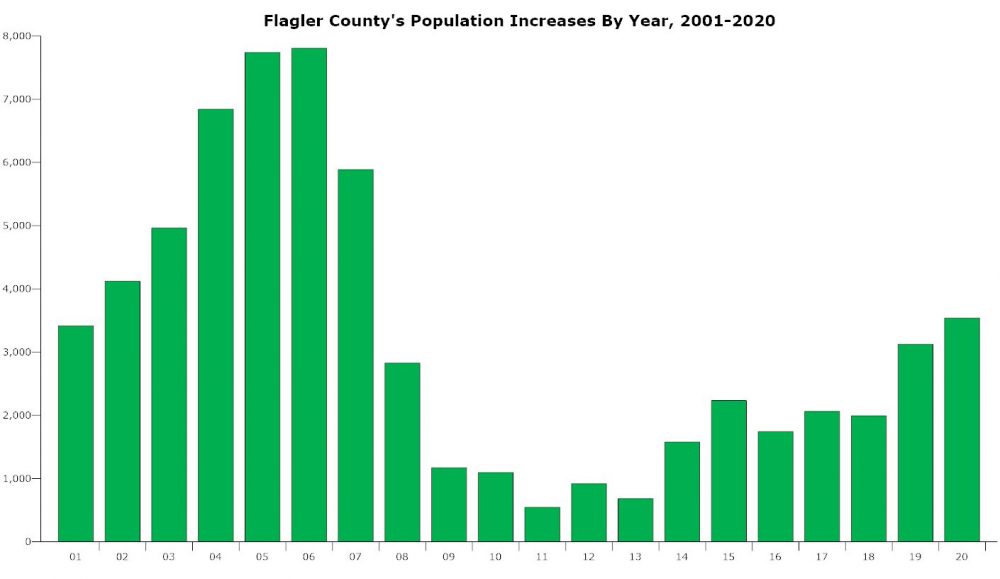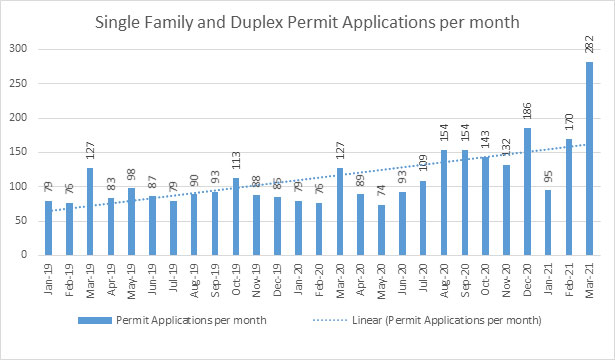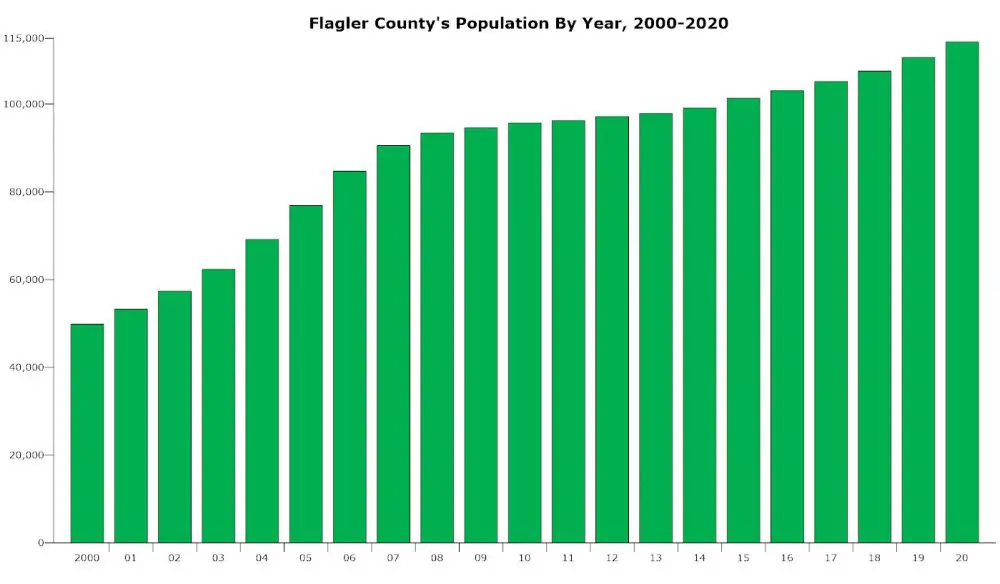
Flagler County in 2020 posted its biggest single-year population gain since 2007, adding 3,538 residents, after an almost equally strong gain in 2019, though–for good or ill–those gains are still less than half what they were at the peak of the county’s boom years between 2004 and 2006, according to the latest estimates by the University of Florida’s Bureau of Economic and Business Research.
The bureau estimated the county’s 2020 population at just under 115,000, or a little less than the Census Bureau’s estimate for July 2019. Flagler added an estimated 6,700 residents in the last two years.
The numbers are part of the bureau’s annual projections of state and county populations, with estimates projected far into the future. Those estimates are of interest to local government planners and policy makers, to market analysts and to the housing industry, among others, as calibrate growth management policies and plan for coming demand.
After a long delay, the Census Bureau on Tuesday released the first in a long series of significant data sets from the decennial 2020 census, with Florida’s population at 21.5 million (identical to the bureau’s estimate). Florida will gain one congressional seat. But the census’s city and county populations will not be released until late August, a census spokesperson said today, leaving the bureau’s estimates as the most current.
Flagler’s boomlet of the last two years is reflected across several other indicators–property values, which had risen at the sharpest clip in 12 years in 2019 before rising at a somewhat slower pace last year, in the shrinking available inventory of single-family homes, and in the sharp rise in permitting for new single-family homes, which struck a post-crash record in March, when 282 permits were filed. Put another way, more permits were filed last March than for the entire years of 2009, 2010, 2011 and 2012, when permits averaged 210 per year. The March numbers were the highest since March 2006, when the city signed 312 permits. The single-month record, however is 618, in August 2004. Notably, the pace of permitting–and therefore, construction–did not appear affected by the pandemic.

Similarly, nearly 400 sales for single-family homes closed in March, according to the Flagler County Realtors Association, also a post-crash record. Sales have exceeded 300 per month in seven of the last 10 months in the county, with the media sale price also hitting a historic high, at $282,000, placing most new homes out of reach of the working class. At the height of the bubble, the median price in the Flagler-Volusia area was $224,000. The inventory of homes on the market hit another low in March, at just 318, and has fallen from over 1,000 two years ago. Inventory has fallen for 12 months in a row. That points to more permitting and more construction ahead, especially with the economy in recovery and stimulus dollars heating the market.
The only significant sector where the population boomlet has not yet reverberated is in school population figures: the Flagler County School district’s population had been stuck at around 13,000 for more than a decade. The district’s population may have shrunk, if barely, this year, due to the pandemic before recovering, a phenomenon seen in other parts of the state as 2020-21 enrollment figures dropped by 67,000. But despite a steady rise in the county’s population year after year, and the sharp rise in the last two years, enrollment figures continued to be flat, a reflection of the demographic peopling these new homes: it’s been overwhelmingly made up of retirees.
Ten years ago, 19 percent of Flagler’s population was 18 or younger, while just 24 percent was 65 or over. By 2019, just 16.9 percent of the population was 18 or younger, while the 65-and-over proportion had grown sharply to 30.7 percent, an enormous shift for a relatively small county, demographically speaking. That explains why the school district isn’t part of the big population growth–and why AdventHealth Palm Coast is planning a second hospital in Palm Coast, while other health care companies are looking to do the same: Flagler is getting older, and as it gets older, it is likelier to get sick.
The Bureau of Economic and Business Research’s annual projections are mined for their eye on the future: the estimates give population projections in five-year increments through 2045. This being Florida, they’re always somewhat sobering, at least to existing residents, even though many of them were part of that in-migration at one time or another. Sobering, because the numbers point only upward, and sharply so. At current projections, the state’s population is seen rising to 24.4 million in 2045, if the low estimate carries, and to 30 million, if the high estimate carries. The medium projection is for a population of 27.2 million by 2045.
In Flagler County, the low estimate is for 116,000 people by 2025, 128,000 by 2035, and 132,000 by 2045, though it appears the county is already right now near the low estimate for 2025. The medium estimate, which the bureau says is the most likely, has the county’s population rising to 128,000 by 2025, and to 167,000 by 2045. The high estimate would see the population increase 21 percent over the next four years, to 140,000, rising to 212,000 by 2045.
But the bureau’s numbers should be kept in perspective, as–like weathercasters–they have a tendency to miss the mark the further out they go.
Back in 2006, when Flagler County had added about 7,000 residents a year for three years in a row–the highest pace of population growth it’s known in its hundred years–the bureau was estimating that the county would have a population of 140,000 by 2020. That was the low estimate. The mid-range estimate was 168,000, and the high estimate was 201,000. “The medium projection is the one we believe is most likely to provide an accurate forecast of the future population,” the Bureau wrote in a briefing in 2011.
The housing boom burst the following year. By 2011, the low estimate for 2020 had been slashed, but it was still a relatively robust 121,000, with the mid-range estimate at 137,000 and the high estimate at 154,000.
“County projections are based on a variety of statistical techniques that extrapolate historical population trends into the future,” the bureau explains in a briefing. For example, one set of numbers is a linear projection that assumes the population will change by the same number of people each year as the average change from the base period. Another set of numbers applies an exponential rate of growth, with the population increasing at the same percentage rate as the base year. A third set reflects the county’s share of state growth, and applies it at the same rate in future years, and so on. The different sets of numbers, totaling nine sets in all, are averaged out to calculate the three projections (low, middle, high). “In most years, the medium projections for counties are calculated as the average of several individual projections and are controlled to add to the state population projection,” the briefing states. “The low and high projections are based on the distribution of errors from previous sets of projections. Again, the medium projections are those expected to provide the most accurate forecasts.”
The bureau has been estimating county populations since 1985, and the bureau cautions against making too much of the figures when it comes to policy decisions or future planning: “Results for individual counties, of course, are much less predictable than results based on averages. Given this uncertainty, data users should consider several possible alternatives rather than a single scenario when using county-specific projections for decision-making purposes. Population projections provide valuable tools, but they must always be accompanied by a careful analysis of historical trends and a thoughtful evaluation
of alternative scenarios when planning for the future.”
This, too, is worth bearing in mind: when ITT was planning Palm Coast alone in the early 1970s, it was projecting a population of 600,000 by 2000. “Two years ago we told them they were building a dinosaur–an anachronism–that was years out of date as far as enlightened development goes,” Joel Kuperberg, then the director of Florida’s Internal Improvement Fund (under the Department of Environmental Protection, when the agency had stronger teeth than it has had since) told a New York Times reporter in 1974, referring to the ITT Corporation that developed Palm Coast. “Here we have the world’s mightiest corporation walk into Florida with a plan that is 10 years out of date.” By the time Kuperberg died in 2005, Flagler’s entire population was hovering around 85,000.






























Shelly says
That’s because people are getting smart and moving out of the blue states that are keeping everyone and everything on lockdown a year later.
Steve says
Fyi Most dont move here for Politics. Maybe more recently but its usually Demographics Quality of life and Taxes/Estate planning and weather
CB from PC says
And what exactly, in your mind, are the attributes of “quality of life”? Lockdowns, high crime, high taxes and fiscally mismanaged cities/states under Democrat Administrations?
Yep, the lack of all these and more, is why people come here.
Mike Cocchiola says
Ugg! All the population growth shows up at the intersection of OldKings Rd and Palm Coast Parkway around noon every day. And it’s certainly getting harder to find parking in Flagler Beach. Price of progress.
Jimbo99 says
Uggghhhh, tell me about it, they’re building duplexes all over the neighborhood and those are being overutilized. Not liking this overpopulation growth one bit. I now have tire burn out marks in the street, also had my mailbox damaged. The growing pains are not an upgrade in the quality of life here. Glad they finally installed street lights on Belle Terre South, but that isn’t making the side streets of the neighborhoods any better or safer as the population growth continues.
Dennis C Rathsam says
I moved here 10 years ago, peacefull,quiet,I thought it would be a great place to retire, then the houses, began to pop up everywhere. People comming in masses….Traffic like in Jacksonville, here in Palm Coast. Ive noticed more litter, and more crazy drivers that are in a extreme hurry. Our roadways , the ones you use to get around town are a mess, traffic lights turn green…then less than a mile the next one is red. This constant start, stop is creating green house gases that are killing out planet. Our quality of life is slowly dieing. I wish the mayor and council will stop and think about what their doing before, before Palm Coast turns into a giant parking lot.
Mark says
Why do we want or need more population?
Bri says
And let’s build another huge apartment complex on Pine Lakes to bring even more people. Its disgusting. This used to be such a nice quiet town 15 years ago, now you can barely drive on Belle Terre or Palm Coast Parkway. There are no jobs here to support any of this growth. You can thank Holland and the others. Next election maybe people will smarten up and get her and the rest of them OUT!
tulip says
The thing is that if a person owns land, that person cannot be prevented from selling his land to someone and that someone has a right to build what they want within city guidelines. So there were people that bought land for future investment and this is the time. Our population all over the country is growing by leaps and bounds and someday the future generations may will be all jammed together like China, India and other countries.
TR says
For those who were here before 1999. It all the peoples fault who voted to incorporate the Palm Coast into a city. I tried to explain to people back then it would be a mistake in the long run. No one to blame but the people who voted to incorporate. Oh btw, I voted against it.
Nancy Remmers says
Stupidity! We need to be able to offer good paying jobs! The Palm Coast government has failed us time and again….providing no well paying jobs. What’s the problem?